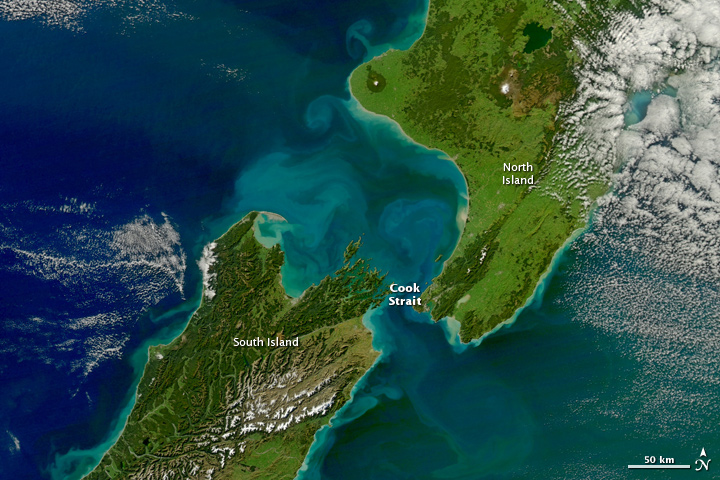NASA: New Zealand - Turbid Waters Surround New Zealand - 03-0311
Posted by Ricardo Marcenaro | Posted in NASA: New Zealand - Turbid Waters Surround New Zealand - 03-0311 | Posted on 20:59
Open your mind, your heart to other cultures
Abra su mente, su corazón a otras culturas
You will be a better person
Usted será una mejor persona
RM
Abra su mente, su corazón a otras culturas
You will be a better person
Usted será una mejor persona
RM
Runoff from heavy rains, combined with wave action along the coast, increased the turbidity of New Zealand’s waters when this image was acquired on April 29, 2011. The Moderate Resolution Imaging Spectroradiometer (MODIS) on NASA’s Aqua satellite captured this view of sediment flowing in the Pacific Ocean.
The volume of sediment in the water hints at rough seas. Distinctive plumes arise from pulsing rivers, while the halo of turquoise around both islands is likely sediment swept up to the ocean surface by powerful waves. The plumes fan out and fade from tan to green and blue with water depth and distance from the shore.
Cook Strait, the narrow strip of water separating the North and South Islands of New Zealand, has a reputation for being among the world’s roughest stretches of water. The islands lie within the “Roaring Forties,” a belt of winds that circles the globe around 40 degrees south. The westerlies hit the islands side on and run into the mountain ranges. Cook Strait is the only opening for the winds, so the channel becomes something of a wind tunnel. Strong winds produce high waves, and they erode the shore as shown in the image.
However, sediment may not be causing all of the color. The waters around New Zealand are rich in nutrients, so it is likely that phytoplankton are contributing to some of the fanciful swirls in the image. Mixing currents bring nutrients to the ocean’s surface, providing a prime environment for plankton blooms. Made up of millions of tiny plant-like organisms, the blooms routinely color the ocean with broad strokes of green and blue.
Phytoplankton are important to New Zealand because the organisms are the base of the ocean food chain. In places where phytoplankton flourish, fish also gather. Commercial fishing is New Zealand’s fourth largest industry.
The volume of sediment in the water hints at rough seas. Distinctive plumes arise from pulsing rivers, while the halo of turquoise around both islands is likely sediment swept up to the ocean surface by powerful waves. The plumes fan out and fade from tan to green and blue with water depth and distance from the shore.
Cook Strait, the narrow strip of water separating the North and South Islands of New Zealand, has a reputation for being among the world’s roughest stretches of water. The islands lie within the “Roaring Forties,” a belt of winds that circles the globe around 40 degrees south. The westerlies hit the islands side on and run into the mountain ranges. Cook Strait is the only opening for the winds, so the channel becomes something of a wind tunnel. Strong winds produce high waves, and they erode the shore as shown in the image.
However, sediment may not be causing all of the color. The waters around New Zealand are rich in nutrients, so it is likely that phytoplankton are contributing to some of the fanciful swirls in the image. Mixing currents bring nutrients to the ocean’s surface, providing a prime environment for plankton blooms. Made up of millions of tiny plant-like organisms, the blooms routinely color the ocean with broad strokes of green and blue.
Phytoplankton are important to New Zealand because the organisms are the base of the ocean food chain. In places where phytoplankton flourish, fish also gather. Commercial fishing is New Zealand’s fourth largest industry.
References
- Ministry for the Environment. (2007, September 17). Importance of oceans to New Zealand. New Zealand Government. Accessed May 13, 2011.
- New Zealand History Online. (2009, January 12). Rough crossings—Cook Strait ferries. New Zealand Ministry for Culture and Heritage. Accessed May 13, 2011.
NASA image courtesy Norman Kuring, Ocean Color Team. Caption by Holli Riebeek.
- Instrument:
- Aqua - MODIS
NASA: New Zealand - Turbid Waters Surround New Zealand - 03-0311
You have an alphabetical guide in the foot of the page in the blog: solitary dog sculptor
In the blog: Solitary Dog Sculptor I, the alphabetical guide is on the right side of the page
Thanks
Usted tiene una guía alfabética al pie de la página en el blog: solitary dog sculptor
En el blog: Solitary Dog Sculptor I, la guia alfabética está en el costado derecho de la página
Gracias
Ricardo M Marcenaro - Facebook
Blogs in operation of The Solitary Dog:
solitary dog sculptor:
http://byricardomarcenaro.blogspot.com
Solitary Dog Sculptor I:
http://byricardomarcenaroi.blogspot.com
Para:
comunicarse conmigo,
enviar materiales para publicar,
propuestas comerciales:
marcenaroescultor@gmail.com
For:
contact me,
submit materials for publication,
commercial proposals:
marcenaroescultor@gmail.com
Diario La Nación
Argentina
Cuenta Comentarista en el Foro:
Capiscum
My blogs are an open house to all cultures, religions and countries. Be a follower if you like it, with this action you are building a new culture of tolerance, open mind and heart for peace, love and human respect.
Thanks :)
Mis blogs son una casa abierta a todas las culturas, religiones y países. Se un seguidor si quieres, con esta acción usted está construyendo una nueva cultura de la tolerancia, la mente y el corazón abiertos para la paz, el amor y el respeto humano.
Gracias :)



Comments (0)
Publicar un comentario